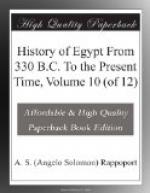Herophilus lived about the same time with Erasistratus, and was, like him, famous for his knowledge of the anatomy of man. But so hateful was this study in the eyes of many, that these anatomists were charged by writers who ought to have known better, with the cruelty of cutting men open when alive. They had few followers in the hated use of the dissecting-knife. It was from their writings that Galen borrowed the anatomical parts of his work; and thus it was to the dissections of these two great men, helped indeed by opening the bodies of animals, that the world owed almost the whole of its knowledge of the anatomy of man, till the fifteenth century, when surgeons were again bold enough to face the outcry of the mob, and to study the human body with the knife.
Hegesias of Cyrene was an early lecturer on philosophy at Alexandria. His short and broken sentences are laughed at by Cicero, yet he was so much listened to, when lecturing against the fear of death, and showing that in quitting life we leave behind us more pains than pleasures, that he was stopped by Ptolemy Soter through fear of his causing self-murder among his hearers. He then wrote a book upon the same subject, for though the state watched over the public teaching, it took no notice of books; writing had not yet become the mightiest power on earth. The miseries, however, of this world, which he so eloquently and feelingly described in his lectures and writings, did not drive him to put an end to his own life.
Philostephanus of Cyrene, the friend of Callimachus, was a naturalist who wrote upon fishes, and is the first investigator that we hear of who thought it desirable to limit his studies to one branch of the science of natural history.
But Cyrene did not send all its great men to Alexandria. Plato had studied mathematics there under Theodorus, and it had a school of its own which gave its name to the Cyrenaic sect. The founder of this sect was Aristippus, the pupil of Socrates who had missed the high honour of being present at his death. He was the first philosopher who took money from his pupils, and used to say that they valued their lessons more for having to pay for them; but he was blamed by his brethren for thus lowering the dignity of the teacher. He died several years before Ptolemy Soter came into Egypt. The Cyrenaic sect thought happiness, not goodness, was the end to be aimed at through life, and selfishness, rather than kindness to others, the right spring of men’s actions. It would hardly be fair to take their opinions from the mouths of their enemies; and the dialogues of Socrates, with their founder, as told to us by Xeno-phon, would prove a lower tone of morality than he is likely to have held. The wish for happiness and the philosophical love of self, which should lead to goodness, though a far worse rule of life than the love of goodness for its own sake, which is the groundwork of religion, was certainly far better than unguided passion and




